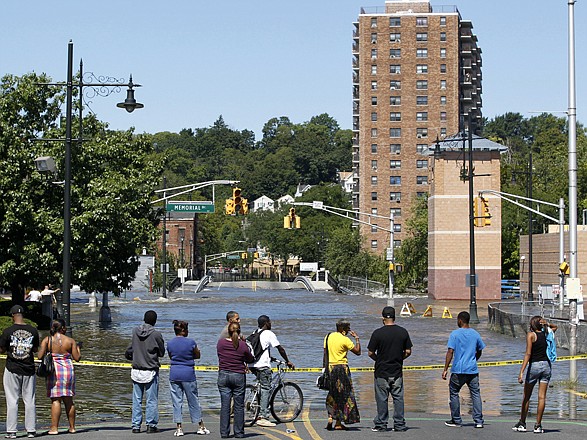NEWFANE, Vt. (AP) - National Guard helicopters rushed food and water Tuesday to a dozen cut-off Vermont towns after the rainy remnants of Hurricane Irene washed out roads and bridges in a deluge that took many people in the landlocked New England state by surprise.
"As soon as we can get help, we need help," Liam McKinley said by cellphone from a mountain above flood-stricken Rochester, Vt.
Up to 11 inches of rain from the weekend storm turned placid streams into churning, brown torrents that knocked homes off their foundations, flattened trees and took giant bites out of the asphalt across the countryside. At least three people died in Vermont.
"I think that people are still a little shell-shocked right now. There's just a lot of disbelief on people's faces. It came through so quickly, and there's so much damage," Gail Devine, director of the Woodstock Recreation Center, said as volunteers moved furniture out of the flooded basement and shoveled out thick mud that filled the center's two swimming pools.
As crews raced to repair the roads, the National Guard began flying in supplies to the towns of Cavendish, Granville, Hancock, Killington-Mendon, Marlboro, Pittsfield, Plymouth, Rochester, Stockbridge, Strafford, Stratton and Wardsboro. The Guard also used heavy-duty vehicles to bring relief to flood-stricken communities still reachable by road.
The cut-off towns ranged in population from under 200 (Stratton) to nearly 1,400 (Cavendish).
"If it's a life-and-death situation, where someone needs to be Medevac-ed or taken to a hospital, we would get a helicopter there to airlift them out, if we could get close to them. A lot of these areas are mountainous areas where there may not be a place to land," said Mark Bosma, a spokesman for Vermont Emergency Management.
There were no immediate reports of anyone in dire condition being rescued by helicopter.
But it took a relay operation involving two ambulances and an all-terrain vehicle to take a Killington woman in respiratory
distress to a hospital in Rutland, about 13 miles away, after floodwaters severed the road between the two communities, Rutland Regional Medical Center President Tom Hubner said. The patient, whose name was not released, was doing fine, he said.
In Rochester, where telephones were out and damage was severe, people could be seen from helicopters standing in line outside a grocery store. McKinley said the town's restaurants and a supermarket were giving food away rather than let it spoil, and townspeople were helping each other.
"We've been fine so far. The worst part is not being able to communicate with the rest of the state and know when people are coming in," he said.
He said government agencies did a good job of warning people about the storm. "But here in Vermont, I think we just didn't expect it and didn't prepare for it," he said. "I thought, how could it happen here?"
Wendy Pratt, another of the few townspeople able to communicate with the outside world, posted an update on Facebook using a generator and a satellite Internet connection. She sketched a picture of both devastation and New England neighborliness.
"People have lost their homes, their belongings, businesses ... the cemetery was flooded and caskets were lost down the river. So many areas of complete devastation," Pratt wrote. "In town there is no cell service or internet service - all phones in town are out. We had a big town meeting at the church at 4 this afternoon to get any updates."
"Mac's opened up at 5 and gave perishables away to anyone who came," she added. "The Huntington House put on a big, free community dinner tonight."
Access to Rochester and Stratton by road was restored later in the day, officials said.
All together, the storm has been blamed for at least 44 deaths in 13 states. More than 2.5 million people from North Carolina to Maine were still without electricity Tuesday, three days after the hurricane churned up the Eastern Seaboard.
While all eyes were on the coast as Irene swirled northward, some of the worst destruction took place well inland, away from the storm's most punishing winds. In Vermont, Gov. Peter Shumlin called it the worst flooding in a century. Small towns in upstate New York - especially in the Catskills and the Adirondacks - were also besieged by floodwaters.
Michael Ricci of Woodstock, Vt., spent the day clearing debris from his backyard along the Ottauquechee River. What had been a meticulously mowed, sloping grass lawn and gorgeous flower beds was now a muddy expanse littered with debris, including wooden boards, propane tanks and a deer hunting target.
"The things we saw go down the river were just incredible," he said. "Sheds, picnic tables, propane tanks, furnaces, refrigerators. We weren't prepared for that. We had prepared for wind and what we ended up with was more water than I could possibly, possibly have imagined." He said the water in the yard was almost up to the house, or about 15 to 20 feet above normal.
He added: "The force of it was beyond our comprehension."
Vermont emergency officials and the National Weather Service warned before the storm about the potential for heavy rain and flooding. On Thursday, Shumlin recommended stocking up on enough food, water and other supplies to last three days.
On Tuesday, the governor defended his state's decision not to undertake extensive evacuations before the storm arrived, noting that it was too hard to predict which communities in a rugged place like Vermont would get hit.
"You'd have to evacuate the entire state," he said.
Approximately 260 roads in Vermont were closed because of storm damage, along with about 30 highway bridges. Vermont Deputy Transportation Secretary Sue Minter said the infrastructure damage was in the hundreds of millions of dollars.
Relief supplies arrived at Vermont's National Guard headquarters early Tuesday in a convoy of 30 trucks from the Federal Emergency Management Agency. Accompanied by Shumlin, FEMA administrator Craig Fugate toured the state by helicopter Tuesday to survey the damage.
Meanwhile, in North Carolina, where Irene blew ashore along the Outer Banks on Saturday before heading for New York and New England, Gov. Beverly Perdue said the hurricane destroyed more than 1,100 homes and caused at least $70 million in damage.
Airlines said it would be days before the thousands of passengers stranded by Irene find their way home. Amtrak service was still out Tuesday between Philadelphia and New York because of flooding in Trenton. Commuter train service between New Jersey and New York City resumed Tuesday, except for one line that was still dealing with flooding.



